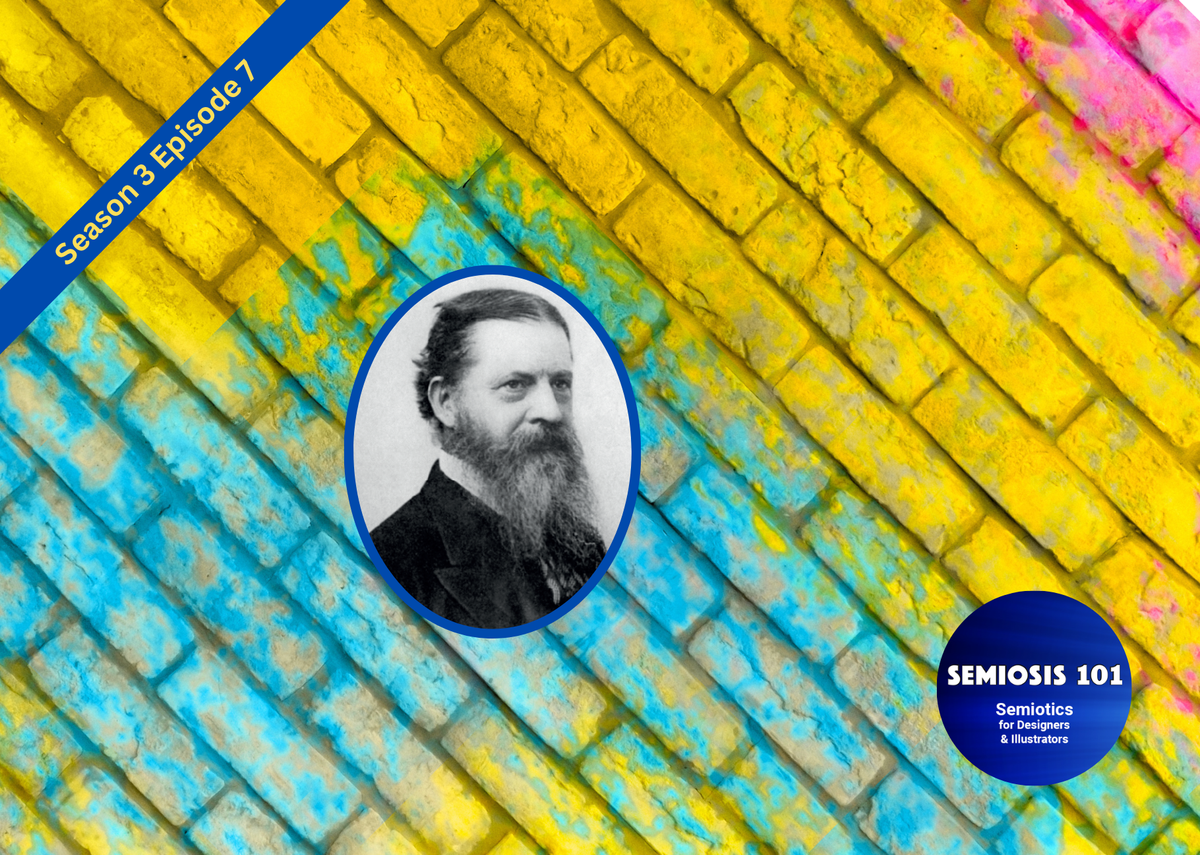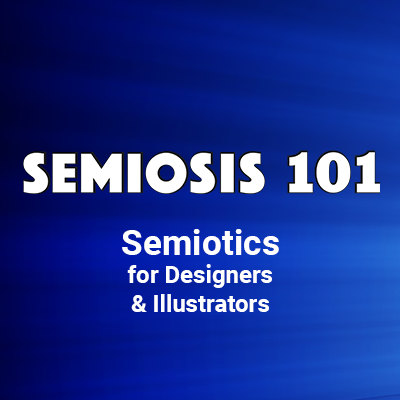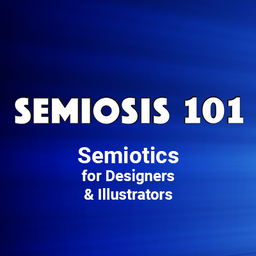Free Semiosis 101 Transcript 3.7:

MEANING-BEARING VISUALS: Cementing Semiosis Into Ideation
Hello readers.
In this free transcript for the episode published on Semiosis 101 on Weds 6 December, we will explore how semiotic quality signs can be composited together to build more complex visually communicated meaning. We will not hit a wall, but instead see through one.
Watch the free episode on YouTube for the full impact…
…and here is the episode’s transcript.
In the last episode we saw how the lowest type of semiotic sign is an ephemeral possibility represented through a familiar quality. Peirce, in 1903 defined ten classifications of semiotic signs. We focused on Sign One last week, and will later this season focus on all ten signs.
This week we will build on (pun intended) this first sign class. In designer-centric terms, I defined Sign One’s power as a quality as… possible | familiar | instant. In this episode, we will explore how these semiotic quality signs can be composited together to build more complex visually communicated meaning. We will not hit a wall, but instead see through one. Hit subscribe to this YouTube channel and I will explain…
The trick is to NOT approach Semiosis 101 as a training manual. Semiotics does not work like an engineering problem. You cannot hit a communicational problem, then look up in an A-Z How To… book and follow step-by-step instructions to find a semiotic way to solve it.
Bish… bash… bosh… jobsagudd…ohh!
We are tapping into audience’s perception as much as a creative’s talent to design or illustrate something to someone. To understand human perception a phenomenological and qualitative approach is more productive. This is handy as Peirce’s Semiosis has firm foundations in phenomenology, and the triggering of perception happens through the target audience perceiving familiar qualities. If the first semiotic trigger of perception is through a possible familiar visualised quality, that triggering is subconsciously instantaneous.
Sign One = possible | familiar | instant
If a visual quality is composed in a design or illustration it is not on its own. Designs and illustrations are complex visual entities made up of smaller visual entities. Last week we briefly referenced two fresh examples: one was the FedEx logo and the other was an illustration of a pirate by Joey Guidone. Let us return to these two examples, to explain how complex visual communication can semiotically be crafted to enhance visual communication.
Before I do I first wish to state I will be deconstructing these two examples through Peirce’s Semiosis. While both examples are semiotically rich, I can safely bet the designers and illustrator who created them were working through gut instinct and tacit knowledge. This season I have been stating that you all HAVE ALWAYS been working semiotically. Okay? I will not repeat myself on that point, so let us move on.
In the FedEx logo and Guidone’s pirate illustration they may both at first appear simple. But both are complex examples of effective visual communication. One example is typographic and the other is an image. But they both utilise sophisticated semiotics built up from simple qualities. Let us jump straight in at the sophisticated connotational level first, and then flip to look at the Sign Ones that help visually communicate the deeper meaning.
Once you see the arrow in the FedEx logo and the noose in the pirate you cannot “unsee” them. They are not just intentional BUT crucial. The FedEx arrow suggests left to right MOVEMENT. Communicating movement is crucial for a logistical delivery company. But what of the pirate? The noose emerges from the front of the classical pirate tricorn hat.
Notice I said “classical” instead of “iconic?” These words are interchangeable when describing socio-cultural well known artefacts. BUT Iconic means something else within Peirce’s Semiosis. So I will reserve Iconic to describe semiotic representation rather than classical things.
Okay, back to the hat! The quality of how each of the three corners of a tricorn hat join naturally form a hole, when the three hat brims are curled upwards. This natural quality of a thing, an existent thing, has now been visually hacked by Joey Guidone into the clear shape of a noose. The ultimate fate of a captured pirate. In these examples both the noose and arrow are not there. The Gestalt of figure:ground helps the Iconic representation to suggest them.
There, I have done it. I have introduced Iconic in its rightful place to describe the use of visual building blocks, to possibly suggest the familiar qualities that a real arrow shape and noose possess. The noose shape is formed from both the quality of the natural shape of a pirate’s hat AND from the suggestion of the brim’s piping in white. The arrow is formed by the E and x. Both examples employ negative space to form the suggestion of an arrow and a noose. Both are there in plain sight. Both have to be perceived to be triggered.
First you see FedEx or Pirate. That is intentional. That is correct. Then, eventually the arrow and noose can be perceived. Additional meaning has just been perceptually unlocked by the audience who makes this perceptual discovery. Semiotically, both examples function extremely well without this additional unlocked meaning. Yes, one IS type and yes, the other is an illustration. Both are, at a micro level, merely a combination of simple shapes, composited together in certain ways, that allow the audience to either read a word or see a pirate.
The beard is not a real beard. The hat is not a real hat. The letters are nothing more than marks that form letters, that make words, that can be read. Can you see where I am semiotically going with this? We can break both the pirate illustration and logo down into marks, shapes, colours, etc. Individually, in isolation from each other, they are nothing more. But once, they begin to be combined, and then nested with other combinations, they all begin to be meaning-bearing.
It is in this building up from marks, etc. into more and more complex shapes that the meaning-bearing qualities begin to mean more complex things. Back in season one I did an entire episode on how Gestalt theory helps to contextualise the psychological effects of visual communication, while Semiosis helps to enhance visual communication. Check out episode 1.6 from season one.
Okay, back to the micro>macro building of meaning. At the same time these marks exist in semiotic limbo. Schrödinger’s semiotic, if you will. Each mark, line, shape, colour, stroke, etc. can help form more complex elements. Each of these can suggest a quality that possibly could mean something to someone. Semiosis just explains how this is possible. By building up of these visual communication building blocks into more complex elements, creatives are naturally layering Sign One’s together.
Canny creatives ensure they intend every aspect of what they design or illustrate to have some aesthetic purpose in visually communicating. But without a mindfulness that they are shaping meaning as they go, miscommunication can be encoded early. With a mindful semiotic approach this miscommunication can be minimised. If we frame every micro element creatives make as semiotic qualities, then we can begin to see these marks, lines, shapes, colours, strokes, etc. as Iconic representation of familiar qualities. The lowest form of semiotic representation of a concept.
Individually a single quality is semiotically weak at meaning-bearing, but in grouping, layering and compositing these together more complex meanings can be visually encoded. As these semiotic qualities form into stronger forms, the sign-vehicle semiotically delivering this further meaning moves upwards in power. As the sign-action power moves from the ephemerally simple towards more complexity, the Qualisign sign-vehicle of Sign One is replaced with a more powerful communicational delivery method.
In designer-centric term the next two signs can be described as:
Sign Two: possible | familiar | mediated
Sign Three: possible | existent | mediated
The semiotic mortar, cement, glue, …whatever metaphorical binding media you prefer… that binds the semiotic power to communicate is predicated on compounding three facets of semiotic communication together.
Each of Peirce’s ten sign classifications, like his semiotic theory are an interplay between the concept, its representation and interpretation. The way to look at how Peirce defines each semiotic sign power class is to see it as:
Perception Power
(sign intensity)|
Communication Power
(concept representation)|
Delivery Power
(effect on interpreter)
Let us end by unpacking this. In the next few episodes we will flip the conversation to ideation, and how Semiosis is applied. Then we will dig deeper into meaning-bearing. After that we will look at Peirce’s ten sign classifications in more depth. So this episode has prepared the ground for you by focusing on the micro semiotic building blocks of visual communication.
We have now touched on Signs One, Two and Three. Do not panic if it all appears too technical right now. The upcoming episodes will focus on application. I am just exposing you all to the importance to creatives of a semiotic mindset. Encoding pragmatic semiotic signs are a three-way interplay between three power levels of perception, communication and delivery. Bound together they offer creatives many basic, subtle and complex ways to visually communicate meaning.
Semiosis 101 Semiotic Design Resources is a reader-supported publication. To receive exclusive posts and support my work, consider becoming a free or paid subscriber. Paid subscribers get name checked on all future Semiosis 101 YouTube episodes.
===Semiosis 101 Patreon Producer==============
Become a Semiosis 101 Patreon Producer and get a named producer credit on future video episodes, plus watch all new episodes months ahead of YouTube.
===Semiosis 101 Patreon Exclusives==============
Watch longer Patreon-exclusive Semiosis 101 episodes on applying Semiosis into design and illustration…
PATEXC001 How does semiotics work in illustration?





